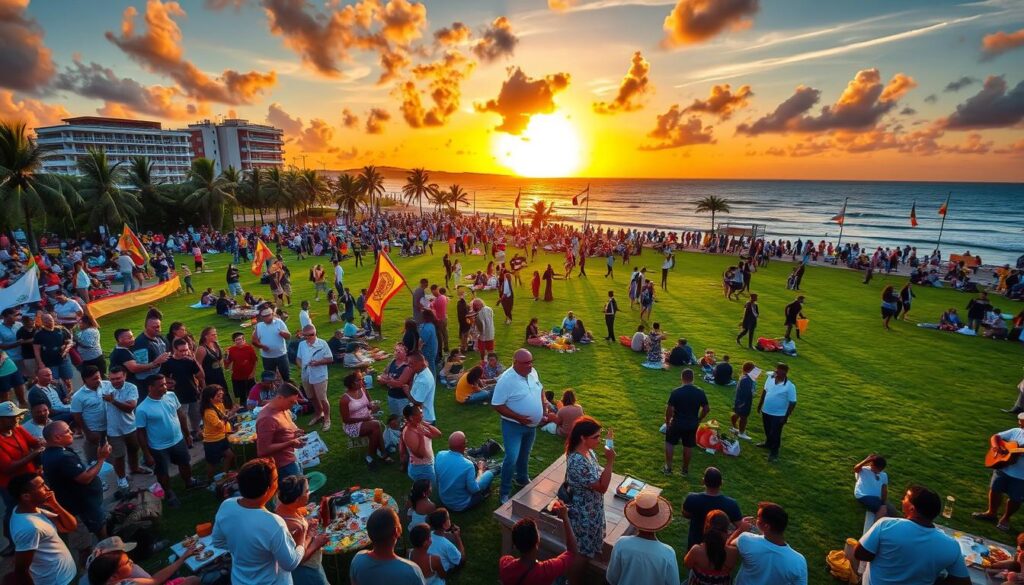Vesak Celebrations Illuminate Sri Lanka Amid Economic Challenges in 2022
Sri Lankans have shown incredible strength by reviving the Vesak festival during a severe economic crisis. This Buddhist celebration has brought hope and unity to people across the country. It has united Sri Lankans from all backgrounds.

The number of dansals and pandals increased during Vesak 2022, despite economic hardships. This revival of traditions shows the nation’s determination to overcome challenges. It marks the beginning of Sri Lanka’s journey towards recovery.
President Ranil Wickremesinghe attended 23 Vesak programs in Colombo. The Buddha Rashmi Vesak Zone was a highlight of the festivities. It was organized by the Hunupitiya Gangarama Temple with help from government agencies.
The Maha Karuna Buddhist Association of Singapore also played a role. This collaboration showcased the unity and resilience of Sri Lankans. It demonstrated their ability to come together during difficult times.
Vesak serves as a beacon of hope for Sri Lanka. It reminds people of their shared heritage and the power of unity. The increased participation in Vesak events from May 23 to 26 is inspiring.
It shows the unwavering spirit of Sri Lankans. Their determination to overcome current challenges is clear. The festival has become a symbol of national resilience and hope.
Revived Vesak Festival Brings Hope and Unity
The revived Vesak festival shines as a beacon of hope in Sri Lanka. It unites people from all walks of life during economic challenges. This Theravada Buddhism celebration showcases the nation’s resilience and solidarity.
Vesak marks the Buddha’s birth, enlightenment, and passing. It holds deep spiritual meaning for most Sri Lankans. This year, it symbolizes the nation’s drive to overcome the socio-economic crisis.
Increased Dansals and Pandals Symbolize Recovery
More dansals and pandals have appeared across the country this Vesak. Dansals are free food stalls set up by communities to help those in need. Pandals are temporary structures with lights honoring Buddha’s teachings.
These traditional elements show the nation’s gradual recovery. They also reflect people’s unwavering faith during tough times.
Sri Lankans Show Resilience and Solidarity
Vesak highlights the remarkable strength of Sri Lankan people. They celebrate this sacred occasion with devotion despite economic challenges. The festival allows people to find comfort in shared traditions.
The full moon’s soft glow reminds us of Sri Lanka’s enduring spirit. Through Vesak, people show their unity and compassion. They pursue a brighter future for their country.
The Importance of Inner Serenity During Challenging Times
Sri Lanka’s 2022 Vesak celebrations brought hope amid economic hardships. People united to find inner peace and harmony. Sri Lankans showed resilience by cultivating mindfulness and embracing interconnectedness.
Dansals and Pandals increased, showing the nation’s recovery. Eastern Orthodoxy and Buddhist traditions both value stillness practices. Sri Lanka’s organic farming shift aimed for sustainability, like cultivating inner peace.
Finding Stillness Amidst Chaos
Nature shows synergy and interdependence in biological relationships. Sri Lankans can achieve harmony by embracing unity in diversity. Political leaders promote unity after tragedies.
Youth participate in peaceful demonstrations for a better system. Their actions show solidarity and desire for change.
Embracing Unity in Diversity
The private sector fosters inclusivity through “difficult conversations” respecting diverse identities. FAO and Norway’s fisheries collaboration shows cooperation’s importance. Recognizing community strengths helps uplift the nation socio-economically and culturally.
Overcoming Collective Human Conditioning
Inner stillness requires stepping out of collective conditioning. Mindfulness helps individuals react without bias. Spiritual practices can guide actions for societal betterment.
Sri Lanka faces economic challenges while reimagining Colombo as a global city. True progress lies in the harmony and well-being of all citizens.

 showcase local talent in Sinhala, Tamil, and English literature. The festivals provide a platform for established and emerging writers to share their works.
showcase local talent in Sinhala, Tamil, and English literature. The festivals provide a platform for established and emerging writers to share their works.